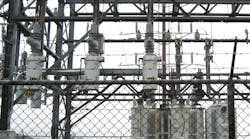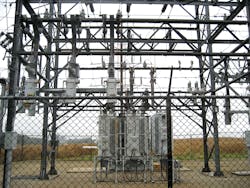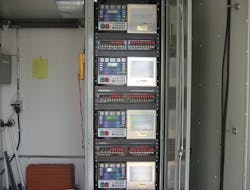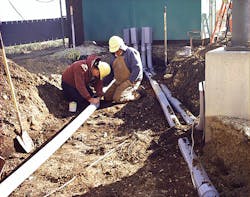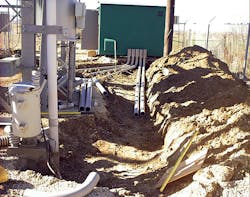Reliable power is important to members of electric cooperatives. A momentary blink can cause problems for manufacturing plants, dairy farms and home-based businesses served by cooperatives. Also, members are installing distributed generation (DG) in the form of wind turbines and solar arrays, which can impact the reliability of the distribution system.
Cooperatives have been providing electricity to members since the 1930s. Some of the original members even assisted with digging holes for poles and stringing wire. Since then, the distribution system has evolved from bringing electricity to rural areas to light a single bulb in a home to a sophisticated technology that provides power to members with critical equipment requiring a reliable electric grid, where power can flow to and from the members.
MiEnergy Cooperative — which serves 18,600 members in southeastern Minnesota and northeastern Iowa, U.S. — believes the sophisticated technology of supervisory control and data acquisition (SCADA) has transformed from a luxury item to a necessary tool for distribution cooperatives. A SCADA system is needed to support MiEnergy’s mission of delivering highly reliable energy services to members at reasonable prices.
Enter SCADA
STAR Energy Services — owned by a group of electric cooperatives, including MiEnergy — prepared a study on the costs and benefits of a SCADA system. After reviewing the study, MiEnergy decided to include a SCADA project in its construction work plan. In October 2017, the utility began the process of installing a SCADA system to monitor and control its 45 69-kV to 12.5-kV distribution substations. The system is designed to gather valuable circuit data and provide the cooperative with real-time load and generation information throughout the grid, from the substation to the member.
STAR prepared a request for proposal that included sizing the system for the needs of MiEnergy and future growth, should the opportunity arise to use the SCADA system as a hosting site for neighboring cooperatives that want to implement SCADA for their distribution. An important part of the bid evaluation was to select a system similar to that used by MiEnergy’s generation and transmission cooperative, Dairyland Power Cooperative. Dairyland has an existing OSI SCADA system, with a large amount of existing data and infrastructure already in place. OSI was awarded the contract because of its competitive cost, its capabilities, and the familiarity MiEnergy and STAR staff have with OSI software.
Technology comes with a cost. The cost of the hardware and software to monitor and control the equipment in MiEnergy’s 45 distribution substations is the minor portion of the cost to implement SCADA. The major cost is replacing hydraulic reclosers in the 69-kV and 12.5-kV distribution substations with electronic reclosers as well as wiring the voltage regulator and recloser controls to the control racks. The cost for MiEnergy to make a substation SCADA-ready is US$100,000 to $150,000 per substation with four feeder exits.
System Features
Features of the SCADA system most important to MiEnergy’s management team are the types of data it can collect, the safety controls available and the overall operational efficiencies. The OSI distribution SCADA will provide MiEnergy the tools it needs to analyze circuit data at any given time.
SCADA gives engineers access to load data, both historical and real time. The data can be used for load studies and to track how DG affects the distribution system. It provides utilities with options to transfer loads automatically and remotely with field equipment. SCADA can notify operations staff of real-time events that affect reliability such as substation recloser operations or voltage regulation concerns. Staff can be notified of these power-quality situations and mitigate the problems before they escalate to outages.
SCADA collects and stores useful information such as load data from substation feeders. This data can be used for reviewing the transfer of load from substations when they are required to be removed from service for maintenance on the substation or to do work on the transmission line connecting the substation. The current and historical load data from substation feeders is used to model the load transfer condition.
This information is entered into the engineering analysis software to simulate the voltage and current with the load transfer condition and provide data to ensure the voltage and capacity guidelines are met during the load transfer period. The substation voltage, current, power factor, and real and reactive power information all can be viewed with SCADA. Electronic equipment can be controlled remotely and settings can be changed with SCADA. This is useful when restoring outages as well as for changing protection settings on reclosers and settings for voltage regulators when load conditions change because of load transfer.
When substation circuits are used to back-feed circuits from other substations, the SCADA system can provide operations staff real-time data on circuit loading and power flow. The data also can be used in engineering analysis to determine whether protective schemes need to be changed for the circuits during back-feeding. Protective schemes then can be changed remotely through the SCADA system. This prevents overloading circuits and ensures correct overcurrent protection is maintained regardless of the configuration of the circuits. These features ensure the electric distribution cooperative provides safe and reliable power to members.
In the past, MiEnergy operations staff was concerned that the older type of oil-circuit reclosers would open the circuit because of overloading during heavy loading periods or when load was transferred between substations. The recloser loading is estimated using historical data instead of real-time data that will be available from the SCADA system through electronic reclosers. With the newer vacuum reclosers controlled by electronic controls, overloading will not be such an issue because of the ability to monitor real-time data.
Historical circuit data maintained and recorded by the SCADA system can make huge improvements in engineering analysis. By incorporating the SCADA data on the circuit with individual load data at the meters through the advanced metering infrastructure (AMI) system, the system engineer has a virtual look at circuit characteristics. This is becoming even more important with the increase in individual DG on the distribution system.
System Flexibility
The increase in DG on the distribution system can create loading issues on circuits as well as power-quality issues. A SCADA system can monitor these issues and the data can be stored for future analysis or as real-time information for alarms and other notification. SCADA enables engineering and operations staff to address issues with individual DG owners.
In addition, SCADA’s remote controlling ability can impact the safety of lineworkers. Crews can ask dispatchers to place circuit reclosers remotely in non-reclosing mode. It takes just a few clicks within the SCADA software to ensure the safety of employees. In an occupation where one slip or a lack of focus can cause severe injuries and even death, this equipment ensures workers will have no accidental contact. The system also has the capability of sensing when something has happened on the circuit and will not allow the recloser to close in.
By remotely controlling the status of the circuit control, central dispatch knows the status of a crew and the crew’s work process. The crew can communicate with the dispatcher about working on an energized line and ask the dispatcher to put the circuit in “one shot” through the SCADA system. The circuit protection operates once to clear the circuit if contact occurs on that circuit. The dispatcher has total control of the circuit. This eliminates a crew having to tag a circuit at the substation, which leaves room for human error because another crew inadvertently could control the circuit manually.
SCADA is useful for troubleshooting power outages. SCADA can use fault-distance calculation data to pinpoint the location of a fault, making outage restoration more efficient. The system engineer can use the system model and data to determine substation impedances and circuit impedance. The existing geographic information system (GIS) data such as conductor types and distances are entered in the model to determine the characteristics of the line.
The engineer also accounts for characteristics of the transmission line and substation equipment used in the recloser control settings. The program in the recloser control can calculate the approximate distance to the fault from the circuit control, and SCADA can be used to display this information to dispatchers, who can dispatch crews to the location of the fault. This saves on outage response time and gives operations staff a heads up to other safety or operations concerns about the location of a fault.
Implementation Status
A majority of MiEnergy’s substations in Iowa are ready to interface with a SCADA system. The conversion from hydraulic to electronic reclosers was started in Iowa and is scheduled to be completed at all distribution substations located in the state in the next few years. Implementation of SCADA in the substations located in Minnesota was delayed because of work plan projects that needed to be completed first, such as building circuit ties and line upgrades. Many of the distribution tie lines in Iowa were rebuilt after ice storms in 2007.
MiEnergy is scheduled to convert three to four substations each year to SCADA-ready equipment. The cooperative estimates it will take five to eight years to make all its Minnesota substations SCADA-ready. The substations are prioritized by engineering analysis and operational benefits.♦
Tom Nigon is a senior electrical engineer at STAR Energy Services LLC. He has worked for more than 35 years with electric utilities in distribution engineering and operations. He currently works with electric cooperatives and municipal utilities providing planning, rate studies and distribution engineering studies. He works on various projects to improve electric delivery systems. He holds a BSEE degree and an MBA degree and is a professional engineer.
Chad Chaffee is vice president of operations Minnesota for MiEnergy Cooperative. He got his start in the utility industry 24 years ago as engineering technician for the city of Moorhead, Minnesota assisting with distribution line and substation projects. He began work at MiEnergy’s predecessor, Tri-County Electric Cooperative, in 2003 as a staking engineer and worked his way up to supervising the design department.
Mike Walton is vice president of system operations Iowa for MiEnergy and has 27 years of experience in the electric distribution cooperative industry. He began his career in Cresco, Iowa, at Hawkeye REC, MiEnergy’s predecessor, as an apprentice lineman. Since then, he has held titles of operations technology supervisor, line superintendent and operations manager.
Check out the February 2018 issue for more articles, news and commentary.
